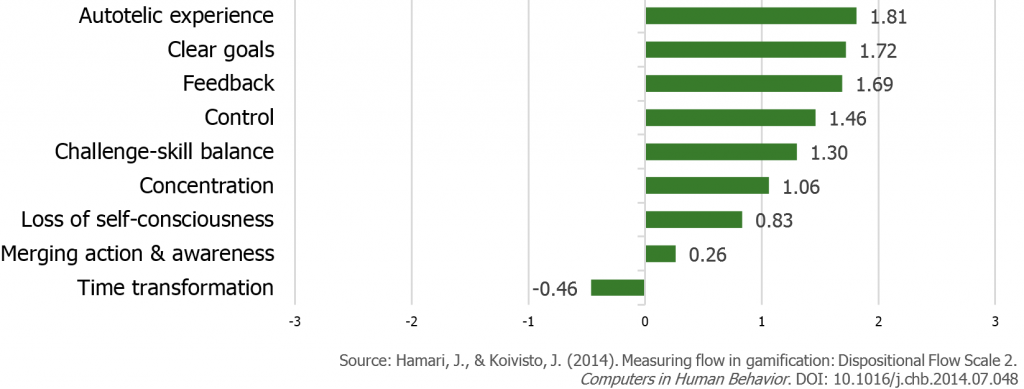Flow – a state of optimal experience characterized being fully focused and engaged in an activity – has been regarded as one of the most important psychological outcomes of gamification and games. It is most commonly understood to comprise of nine dimensions: challenge-skill-balance, clear goals, control, (immediate) feedback, autotelic experience,loss of self-consciousness, time transformation, concentration, and merging action-awareness. Currently, there are few studies investigating flow particularly in the context of gamification (See Hamari, Koivisto & Sarsa, 2014) and therefore there is little knowledge as to which dimensions of flow would be especially emergent in the context of flow. To this end we conducted a two-fold study: 1) We investigated the salience of the different dimensions of flow in gamification and 2) the psychometric properties of the DFS-2 flow measurement instrument.

1) Expectedly, the common gamification implementation of badges, quests, points and levels (which were the primary mechanics in the studied context) seem to, indeed, promote the experiences of having clear goals, receiving (immediate) feedback and having a balance of skill and challenge which further seem to strongly lead to or co-exist with an autotelic experience (or intrinsically driven behavior). Experiences that are typically linked to immersive experiences rather than goal-oriented behavior, such as time transformation, loss of self-consciousness and merging of action-awareness, were less salient in the gamified context.
2) Most previous works on flow do not consider the causality or the relationships between the dimensions of flow but rather regard all of them as reflective of an overall flow state. However, some earlier discussions regarding the flow dimensions have considered the challenge-skill-balance, clear goals, control, and feedback as conditions required for reaching flow (Nakamura & Csíkszentmihályi, 2002; Csíkszentmihályi, 1990), whereas autotelic experience, loss of self-consciousness, time transformation, concentration, and merging action-awareness have been considered outcomes from reaching the flow state.
The analyses carried out in this paper also suggest that flow could be seen as divided into a collection of conditions for reaching flow and the psychological outcomes that follow from reaching the flow state. However, the results also suggest that in the gamifed context, the autotelic experience is very highly correlated with the conditions. There might be two alternative interpretations for this: 1) either in a gamification context, autotelic experience indeed is a condition for reaching flow, implying that people are more likely to reach flow state if the activity is intrinsically motivated to begin with, or 2) autotelic experience is simply very highly co-existent with conditions of flow compared to other outcomes from reaching flow. This could imply that gamification leads to an intrinsically motivated activity far more strongly than to the other more immersion-oriented dimensions. Such a close correlation was not found in video game contexts in other studies using the same measurement instrument (See e.g. Procci et al., 2012). This could suggest that when compared to pure gaming, in gamification the autotelic experience is indeed more closely associated with the optimal goal-driven challenge-skill experience that is characteristic to the core of gamification implementations. In games, the autotelic experience might also be caused by other factors that are missing from a common gamification implementation, such as audiovisual stimuli and immersion (See e.g. Hamari & Tuunanen, 2014; Yee, 2006 on gaming motivations). Interestingly, in the data the mean of time transformation was negative. This could possibly be explained by the fact that gamification commonly attempts to make the activity more structured, and therefore, people might be more conscious of time.
Summary of results
- Expectedly, autotelic experience, clear goals, (immediate) feedback, control and challenge-skill balance were the most salient dimensions of flow in gamification (of exercise) whereas time transformation, merging action-awareness, loss of self-consciousness were the least salient.
- Rather than all nine dimensions of flow being reflective of the overall flow, the study suggests that dimensions of flow divide into highly inter-correlated conditions of flow (challenge-skill-balance, clear goals, control, feedback, and autotelic experience) and into possible outcomes from reaching flow (loss of self-consciousness, time transformation, concentration, and merging action-awareness).
Abstract
This paper measures flow in the context of gamification and investigates the psychometric properties of the Dispositional Flow Scale-2 (DFS-2). We employ data gathered from users of an exercise gamification service (N=200). The results show that the original DFS-2 factorial structure does result in a similar model fit as the original work. However, we also present a factorial respecification that satisfies more recent model fit thresholds. Beyond validating the original DFS-2 instrument in the context of gamification, the psychometric analysis and the respecifications suggest that the components of flow divide into highly correlated conditions of flow (which were also found to be more salient in the context of gamification: autotelic experience, balance of skill and challenge, control, clear goals, and feedback) and into possible outcomes (merging action-awareness, concentration, loss of sense of time, and loss of self-consciousness) from achieving flow.
Authors
Juho Hamari
Researcher @ Game Research Lab – University of Tampere
http://juhohamari.com
@VirtualEconomy
Jonna Koivisto
Researcher @ Game Research Lab – University of Tampere
http://jonnakoivisto.com
Reference
Hamari, J., & Koivisto, J. (2014). Measuring flow in gamification: Dispositional Flow Scale-2. Computers in Human Behavior. DOI: 10.1016/j.chb.2014.07.048
Download the paper here. If Researchgate prompts you to register, you can just close the dialogue box and download the paper without registering.
Fantastic! Great to see new research in flow especially with respect to gamification.